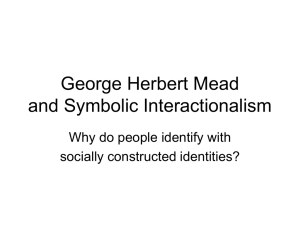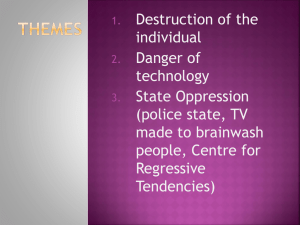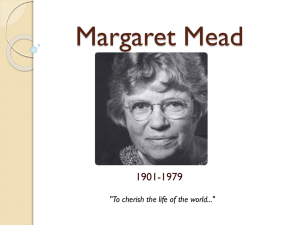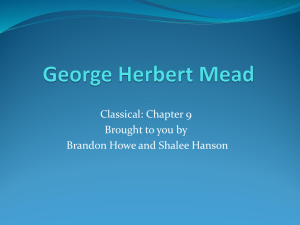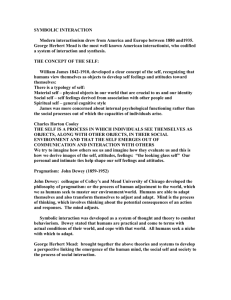Mead on Identity
advertisement
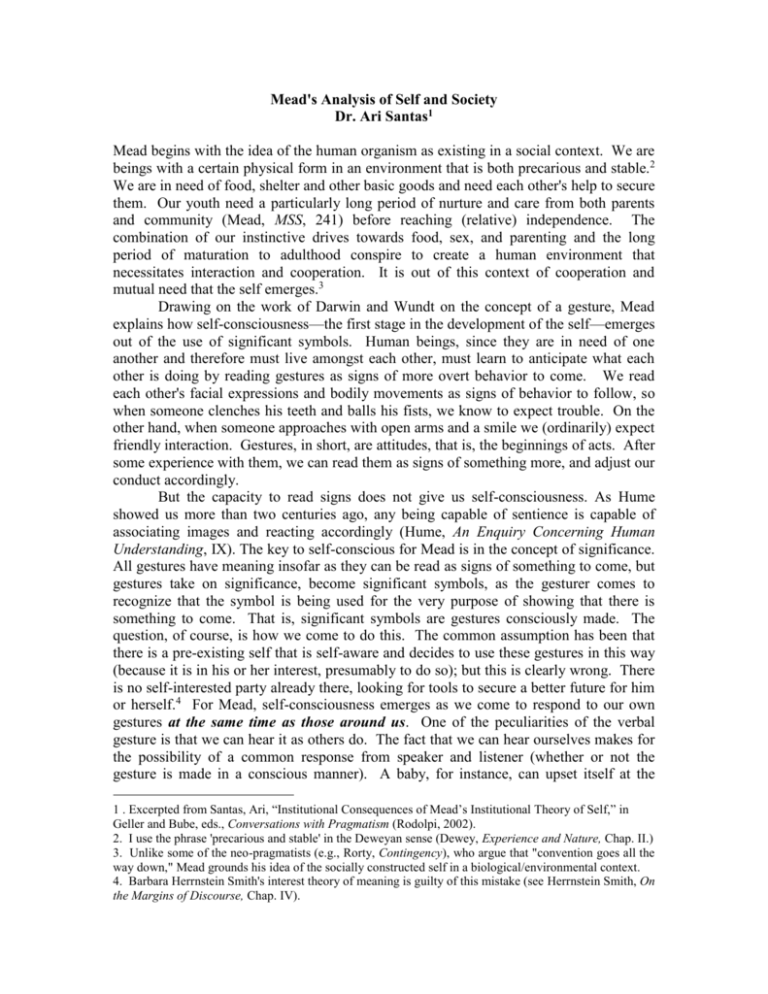
Mead's Analysis of Self and Society Dr. Ari Santas1 Mead begins with the idea of the human organism as existing in a social context. We are beings with a certain physical form in an environment that is both precarious and stable.2 We are in need of food, shelter and other basic goods and need each other's help to secure them. Our youth need a particularly long period of nurture and care from both parents and community (Mead, MSS, 241) before reaching (relative) independence. The combination of our instinctive drives towards food, sex, and parenting and the long period of maturation to adulthood conspire to create a human environment that necessitates interaction and cooperation. It is out of this context of cooperation and mutual need that the self emerges.3 Drawing on the work of Darwin and Wundt on the concept of a gesture, Mead explains how self-consciousness—the first stage in the development of the self—emerges out of the use of significant symbols. Human beings, since they are in need of one another and therefore must live amongst each other, must learn to anticipate what each other is doing by reading gestures as signs of more overt behavior to come. We read each other's facial expressions and bodily movements as signs of behavior to follow, so when someone clenches his teeth and balls his fists, we know to expect trouble. On the other hand, when someone approaches with open arms and a smile we (ordinarily) expect friendly interaction. Gestures, in short, are attitudes, that is, the beginnings of acts. After some experience with them, we can read them as signs of something more, and adjust our conduct accordingly. But the capacity to read signs does not give us self-consciousness. As Hume showed us more than two centuries ago, any being capable of sentience is capable of associating images and reacting accordingly (Hume, An Enquiry Concerning Human Understanding, IX). The key to self-conscious for Mead is in the concept of significance. All gestures have meaning insofar as they can be read as signs of something to come, but gestures take on significance, become significant symbols, as the gesturer comes to recognize that the symbol is being used for the very purpose of showing that there is something to come. That is, significant symbols are gestures consciously made. The question, of course, is how we come to do this. The common assumption has been that there is a pre-existing self that is self-aware and decides to use these gestures in this way (because it is in his or her interest, presumably to do so); but this is clearly wrong. There is no self-interested party already there, looking for tools to secure a better future for him or herself.4 For Mead, self-consciousness emerges as we come to respond to our own gestures at the same time as those around us. One of the peculiarities of the verbal gesture is that we can hear it as others do. The fact that we can hear ourselves makes for the possibility of a common response from speaker and listener (whether or not the gesture is made in a conscious manner). A baby, for instance, can upset itself at the 1 . Excerpted from Santas, Ari, “Institutional Consequences of Mead’s Institutional Theory of Self,” in Geller and Bube, eds., Conversations with Pragmatism (Rodolpi, 2002). 2. I use the phrase 'precarious and stable' in the Deweyan sense (Dewey, Experience and Nature, Chap. II.) 3. Unlike some of the neo-pragmatists (e.g., Rorty, Contingency), who argue that "convention goes all the way down," Mead grounds his idea of the socially constructed self in a biological/environmental context. 4. Barbara Herrnstein Smith's interest theory of meaning is guilty of this mistake (see Herrnstein Smith, On the Margins of Discourse, Chap. IV). sound of its own cry, hearing it, interpreting it as a sign of distress, and responding to it as such (thus creating at the same time an escalation of the original problem!). Initially, the mutual response to the gesture is no doubt unconscious, but after it happens a few times, the gesturer and the audience recognize the similarity of response and begin to identify the two responses as a common response. What results is a simultaneous internalization of other and externalization of self. That is, we see their response as our response and our response as theirs. Mead calls this initial act of self-awareness the first stage in the development of self and characterizes it as "taking the attitude of the other."5 This stage marks our ability to see ourselves as others do. Having internalized the other, we are now in a position to adjust our behavior to accommodate the anticipated response of the other. By the same token, having externalized the self, we can also see others as ourselves and anticipate their behavior by comparing it to our own. The result is the emergence of internal dialogue and the beginning of mental life. This much is achieved by any child spoken to on a regular basis. The first stage of self, self-consciousness, is present in anyone (or anything) capable of linguistic behavior. The next stage—the one that appears to be lacking in so many of us today—is the stage of the unified self. This stage of self is not one that exists as all or nothing, but as more or less. The problem for us is primarily one of how to get more (though sometimes, perhaps, less!). A self, inasmuch as it takes the attitude of the other, acts in anticipation of the response from that other. This response to anticipation of response makes for a self that is dialectical, one that is both subjective (spontaneous) and objective (conventional). Mead expresses this dialectical character of the self in terms of 'I' and 'me.' The 'me' corresponds to an internalized other which makes demands on us (by virtue of our anticipations), and the 'I' is what responds to those demands. The 'I' is spontaneous and the 'me' is conventional. Since we interact with more than one other, this dialectical character is multiply complex. For every association to which we belong there is a set of anticipated responses that we are responding to. That is, there is a 'me' demanding responses from an 'I' for every other with whom we interact. The self, then, is not merely the interaction of an 'I' and a 'me', but a nexus of interacting 'I's and 'me's operating more or less simultaneously.6 Notice that Mead's dialectical picture of self is unlike the accounts given by Aristotle and Kant in at least two ways. First, there is not merely a dual self, but a nexus of interactions of 'I's and 'me's. This recognition of multiple sub-selves accounts for the complex character of human personality in a way that a dual conception cannot. Second, the relation between 'I' and 'me' is fully dialectical, that is, the self is a third7 emerging out 5. What is interesting about Mead's view is that unlike traditional theories of mind, this one asserts that there is no awareness of 'self' without an awareness of 'other' (and vice versa), that the self is not some ontological given; yet unlike a typical behaviorist--who also denies the giveness of self--Mead does not try to explain away the phenomenon of self-consciousness by appeal to reductionist biologism. 6. An ambiguity in Mead here is whether there is one 'I' and many 'me's or many sets of 'I's and 'me's. Presumably he had in mind a single 'I,' but there doesn't seem to be a reason for excluding the other possibility. Although the resolution of this ambiguity may have some bearing on the issue of unity, answering such a question is beyond the scope of this essay. 7. I use the term 'third' here in the Peircean sense. Peirce argues that there are three categories of being: Firstness, an immediate, unanalyzable present, Secondness, a lawless struggle in experience with the of this interaction. Both Kant and Aristotle had identified the "true self" with reason and had viewed the other half of our dualistic nature as somehow extraneous or corrupting; Mead, on the other hand, picks no favorites, but simply acknowledges the complexity of the human self. This view of self as complex nexus of sub-selves inverts some of our old questions regarding personality. In the past we might have been tempted to ask how multiple-personality and schizophrenia are possible; the better question given the foregoing analysis is whether and how there can be unity at all! Perhaps this is what David Hume had in mind when he turned his gaze inward in search of a self and declared that all he could find was a bundle of perceptions. All one needs to do is reflect on the various directions her roles are pulling her if she wants to feel doubtful about who she is. For Mead, the answer to the question of unity lies in the concept of the "generalized other." To the extent that the various activities in which we engage have a common goal, or, end-in-view, we shall interpret our various responses to the various demands eliciting them as many responses to the same basic demand. To the extent that these common goals are missing, we are likely to look upon each other as objects of indifference, at best, mistrust, at the worst. Mead uses the game of baseball to illustrate. Players are required to do many things during a game. A short stop must catch the ground ball heading towards her, anticipating the throw to the awaiting first baseman, 8 or to second base (if there's a runner at first), or elsewhere as the situation demands. There are a variety of responses to a single event of a ground-ball-hit-at-short, though the idea in each case is the same--retire the side. As a hitter, the same short stop is required to perform actions quite different from the acts of fielding, but the overall call to response is the same—to win the game. Similarly, the various roles played by the players have a common end-in-view, so that the various demands of the teammates have become internalized as instances of a general demand to win the game. We might even go beyond the winning mentality and see even the demands of the umpires and members of the other team as general demands for excellence in athleticism and spirit. Or we might, on the other hand, fall into the common trap of hyper-individualizing our behavior. "Show-boating" is a relatively benign example of this, accepting bribes is a malignant one. The internalization of general demands is what Mead calls "taking the attitude of the generalized other." This attitude is the key to unifying the disparate modes of behavior of an individual into a unified body of conduct and what makes for the second stage of self: an individual with a self-concept, with personal identity, or, character. Unified conduct creates unified selves. As the demands of the others solidify into common goals, we generalize the internalized others into a generalized other. What makes this organization of demands possible is an organization of associations, what Mead calls an institution. For every generalized other whose attitude we take, there is an organization of activity--an institution--that makes this possible. Just as there are various selves working together to form an institution, there are (by virtue of the institution) various sub-selves "working together" to form a unified self. objects of perception, and Thirdness, a source of meaning and law which is irreducible to either of the previous categories (see Peirce, "The Principles of Phenomenology"). 8. The fact that the ball is sometimes dropped because the fielder is looking towards first base instead of the ball is testimony to this anticipation. Society, on this account, is not merely a collection of individuals, and not merely an organization of individuals; it is an organization of organizations of organized attitudes. There are sub-selves which themselves make up selves, which make up institutions, which in turn make up "super institutions," or, society at large. Society, in its most complex form, is the interaction of all these entities. Interestingly, every entity in the process can be characterized both as a self and as a society, but this is only because Mead has blurred the distinction between self and society. Such an account explains why Mead saw institutions as personal sort of entities, organizations that could be called organisms, and really a type of self. But we must be careful. Mead did not follow Hegel in making the organic whole more important than the individual. Although our task here is to find how one might acquire more unity in the self we have to acknowledge that too much unity can be just as pernicious as not enough (actually, more pernicious, given our long history of organized atrocity). Liberals, libertarians, and anarchists tend to be suspicious of institutions, and for good reason. Institutions have always tended to be static beings, putting more emphasis on convention and conformity that anything else. The result has been a brutal uniformity imposing itself on individuality and difference. Less official institutions such as gangs and cults are also capable of exploiting our desire for stability and unity for inappropriate purposes. But the tendency towards complete uniformity is nothing more than what it is—a tendency. Institutions can also be dynamic inasmuch as they can allow for growth and change within their organization. What we need is a balance, in both our institutions and in our personhood, between too much unity and not enough. A dynamic structure which finds this balance is Dewey's and Mead's ideal of democracy.
